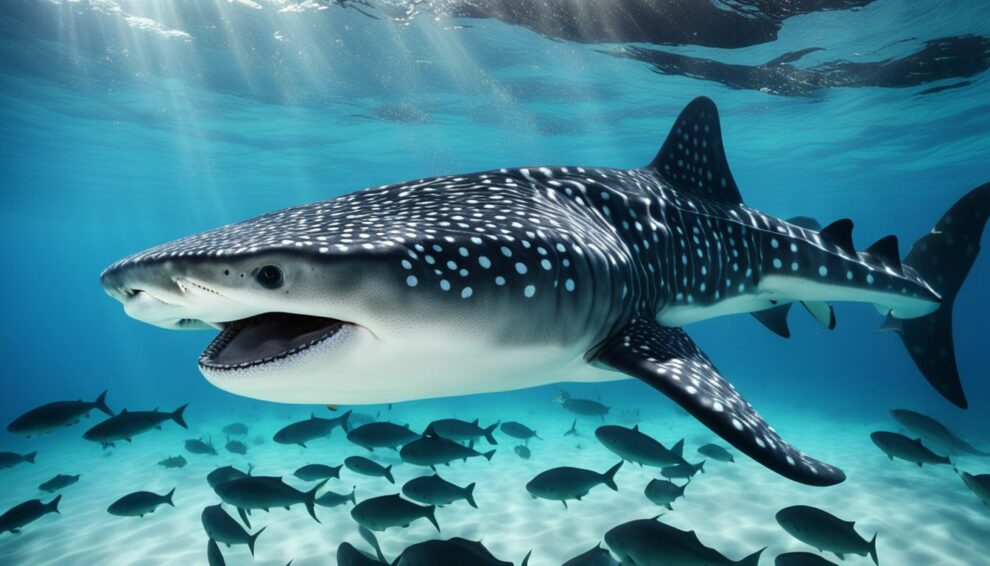Whale sharks are the ocean’s gentle giants, carrying a demeanor as calm as the deep blue in which they reside.
These spotted behemoths glide through tropical seas, opening wide mouths to filter feed on the tiniest of ocean dwellers—plankton and small fish.
Unlike their ferocious cousins, whale sharks prefer the buffet of the microscopic, sieving the seas with gill rakers rather than hunting with sharp teeth.
Imagine a living vacuum cleaner leisurely swimming along, keeping the waterways clean and clear.

Spotting a whale shark is a rare treat that snorkelers and divers treasure.
Their impressive size can be as grand as a school bus, yet they’re as peaceful as a passing cloud.
They gather in certain hotspots around the globe, often where the water teems with their planktonic feasts.
Have you ever wondered what it would be like to swim alongside one, watching it effortlessly scoop up thousands of plankton in a single gulp?
It’s like watching a floating parade that celebrates the wonder of the marine world, one gentle filter feed at a time.
Whale sharks’ lives are laced with mystery.
Scientists are still piecing together their long migratory paths and understanding their impact on ocean ecosystems.
Did you know that these creatures can live for decades, maybe even over a century?
Each one carries unique star-like patterns on its skin, which researchers can use much like fingerprints to identify individuals.
As they migrate, they connect oceans and the stories of the seas, becoming ambassadors to remind us of the underwater world’s delicate balance and intrigue.
Whale Shark Basics
Whale sharks hold the title of the world’s largest fish, and seeing one up close is like watching a gentle giant glide through the sea.
These mammoth creatures spark a sense of wonder in anyone lucky enough to observe them.
Size and Appearance
Imagine a school bus gliding under the water, and you’re starting to get close to a whale shark’s size!
They can grow up to 40 feet in length, about as long as a school bus, and can weigh a hefty 20.6 tons. That’s as heavy as three African elephants!
Their skin boasts a unique pattern of white spots and stripes over a dark gray background, which works like a fingerprint as no two whale sharks have the same pattern.
The whale shark’s wide mouth stretches nearly across its full head width and is positioned right at the front, ready to gulp down plankton and small fish.
Behind this colossal mouth, hundreds of tiny teeth line their jaws, but these aren’t used for eating!
Instead, whale sharks slurp up their food through their gills, which act like a strainer to keep the goodies in and send the water back out.
Have you ever seen a video of a whale shark with its large, spotted body just below the water’s surface, seemingly inviting snorkelers to tag along for a leisurely swim?
It’s like they’re big, friendly hosts to a quiet underwater gathering!
With their slow and calm demeanor, it’s no wonder people are enthralled by these polka-dotted giants of the sea.
Feeding Habits

Whale sharks, the gentle giants of the ocean, have a unique way of eating that allows them to feast on tiny prey. Let’s uncover how they do it.
Mechanism of Filter Feeding
Whale sharks swim through the water with their massive mouths wide open, sieving food through their gill rakers—fine, hair-like structures in their gills that act as a strainer.
As water flows over these rakers, it lets through water while trapping food particles.
When the mouth closes, the trapped water gets pushed out through the gills, and the food is swallowed. This gentle process is called ram filter feeding.
Remember those pool strainers you’ve used to catch leaves in the water?
Imagine a whale shark doing something similar in the ocean, but with food!
Did you know that while feeding, a whale shark can process over 2,000 tons of water per hour?
That’s like filtering an entire Olympic size swimming pool in just a few seconds!
Dietary Preferences
Primarily, these spotted behemoths munch on plankton, which includes tiny plants and animals.
They also relish krill, small fish, squid, and occasionally fish eggs that float in the water.
Whale sharks advantage from seasonal feasts like fish spawn or coral spawning events.
During these times, whale sharks can be found in greater numbers, enjoying the abundant buffet.
Have you ever watched snowflakes drift gently down?
Now picture countless plankton swirling in the ocean current, and a whale shark swimming through, leisurely eating its fill.
Their selective diet ensures a balanced ecosystem, maintaining their role as one of the ocean’s pivotal species.
Did you think a creature this size would feed on large fish? Surprise! They prefer the small bites that the ocean offers in plenty.
Ecology and Habitat

Whale sharks hold a unique place in the marine ecosystem, calling warm oceans home while being masters of long-distance travel.
Global Distribution
The whale shark, with its distinctive spotted skin, graces the tropical waters of the world.
They favor warm seas and are commonly found in latitudes closer to the equator.
These gentle giants are residents of numerous seas and oceans, such as the Atlantic, Pacific, and Indian Oceans.
They have been spotted in the coral-filled waters around Australia’s Ningaloo Reef, the coastal regions of the Philippines, and even under the welcoming sun of the Mexican Caribbean.
Each area provides the whale shark with an abundance of plankton, which is vital for their filter-feeding diet.
Migratory Patterns
Have you ever wondered how whale sharks know where to find their next meal?
These creatures are seasoned travelers and follow a pattern of migration that’s closely linked to the bloom of plankton and other food sources like fish spawn.
For instance, they head to the coastal waters of the Yucatan Peninsula from May through September, aligning perfectly with the mass spawning of fish and coral.
Whale sharks have a nomadic lifestyle, often journeying vast distances across oceans.
The tracking of these magnificent animals has revealed migrations that span entire ocean basins, helping scientists understand more about their behavior and the health of our oceans.
Frequently Asked Questions

Whale sharks have a unique way of feeding that may raise many questions.
These FAQs aim to clear up some of the mysteries surrounding these gentle giants of the sea.
How do whale sharks eat without using teeth?
Despite their enormous mouths, whale sharks eat by filtering water through their gills.
They open their mouths wide, take in massive amounts of water teeming with plankton and small fish, and then push the water out through their gills, trapping the food with their sieve-like gill rakers.
Can you believe these gentle giants only munch on tiny sea creatures?
It’s true, whale sharks sustain themselves by eating microscopic plankton, krill, small fish, and fish eggs.
They spend much of their time cruising the oceans’ sunlit layers where these tiny organisms are abundant.
What’s the secret behind the whale shark’s enormous size if they only filter-feed?
Whale sharks may only eat small prey, but they do it in such enormous amounts that they grow to be the largest fish in the sea.
They have adapted to efficiently process large volumes of ocean water to extract their microscopic food.
Isn’t it curious how a fish so big can be so friendly to humans?
Whale sharks show a surprising tolerance for human interaction.
Their slow-moving and docile nature allows snorkelers and divers to approach them, but one should always respect these wild animals and keep a safe distance to avoid disturbing them.
What kinds of waters do whale sharks prefer for their swimming and feeding?
These majestic creatures tend to favor warm, tropical waters.
They are often found in the open sea but sometimes venture into shallow lagoons near coral reefs where plankton is plentiful, especially during seasonal blooms.
How can whale sharks help us understand the health of our oceans?
By studying whale sharks and their feeding habits, scientists can learn about the abundance and distribution of plankton, which is a fundamental component of marine ecosystems.
Changes in whale shark populations and behaviors can signal shifts in ocean health and prompt further investigation.









